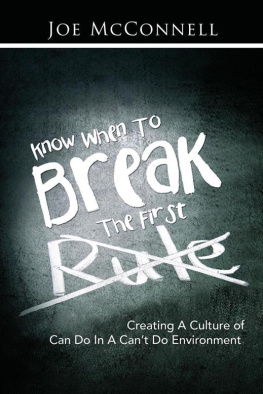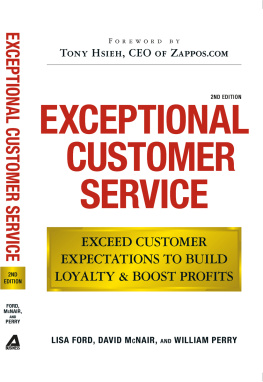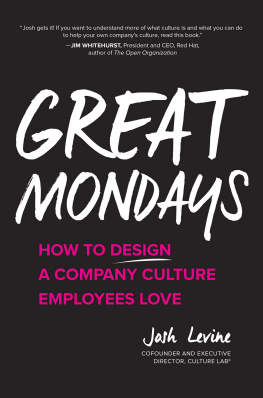KNOW WHEN TO BREAK
THE FIRST RULE
CREATING A CULTURE OF CAN DO IN A CANT DO ENVIRONMENT
JOE MCCONNELL

AuthorHouse
1663 Liberty Drive
Bloomington, IN 47403
www.authorhouse.com
Phone: 1-800-839-8640
2014 Joe Mcconnell. All rights reserved.
No part of this book may be reproduced, stored in a retrieval system, or transmitted by any means without the written permission of the author.
Published by AuthorHouse 10/27/2015
ISBN: 978-1-4969-0849-0 (sc)
ISBN: 978-1-4969-0848-3 (hc)
ISBN: 978-1-4969-0847-6 (e)
Library of Congress Control Number: 2014907873
Any people depicted in stock imagery provided by Thinkstock are models,
and such images are being used for illustrative purposes only.
Certain stock imagery Thinkstock.
Because of the dynamic nature of the Internet, any web addresses or links contained in this book may have changed since publication and may no longer be valid. The views expressed in this work are solely those of the author and do not necessarily reflect the views of the publisher, and the publisher hereby disclaims any responsibility for them.
Table of Contents
I only have two rules.
The first rule: never give a customer a free drink.
The second rule: know when to break the first rule.
Restaurant owner to his newly hired bartender
Introduction
CAN DO VERSUS CANT DO
In the middle of difficulty lies opportunity.
Albert Einstein
All businesses have rules in place to ensure a safe and honest environment. There are also rules in place to ensure profitability. Unfortunately, some rules result in client dissatisfaction. My eighty-three-year-old mother recently bought her first computer. Embracing new technology at eighty-three was cause for celebration, or so you would think. When she called her cable provider to request an Internet connection, she mentioned this providers advertisements for a first-year price special. The offer of ninety-nine dollars per month was a bundled price that included television, phone, and Internet. She was advised that because she was an existing customer, she was not eligible for the special offer. She pointed out that for the past several years, she had been paying more than one hundred dollars for television and phone service. In addition, she had never been late with a payment. She was, in fact, a loyal customer. By the end of the conversation, she was told again that the special price was for new customers only. That was the rule.
It is absurd for any organization to create rules that encourage client defection. It is my hope that this book will empower you to break some of your own rules and create an atmosphere that will enhance your clients experiences and encourage client loyalty. Are you doing everything you can to ensure a positive customer experience? Do some of your policies put your customers in a negative emotional state? Perhaps it is time for you to break some rules. This book will assist you in creating the policies and practices that are essential to building a customer-centric organization.
We have all heard someone share a customer service experience. Perhaps we have shared a few of our own. Often, these experiences begin with a problem, which is what makes these stories compelling. We find ourselves drawn in by these narratives because there are only two possible finales: pleasure or pain. Regardless of the outcome, these stories are told over and over again. In some instances, they become folklore and are passed from generation to generation. We all know someone who will only drive a specific make of car or will never shop at a specific store, usually because of an experience that had occurred years ago. I can recall a story of someone who refused to shop at a specific department store because, ten years prior, his mother had been mistreated. I knew of another family who only drove Ford vehicles because GM had sold Grandpa a lemon and refused to provide a replacement. As businesspeople, we possess the ability to create memorable customer experiences. How your customers remember you and your business will determine the ending to their story, or should I say your story. You own your customers story because your customers story is your brand.
Most organizations strive to provide their customers with exemplary service, but they dont always succeed. It is impossible to satisfy every customer, but it is imperative that you use every means available to limit any negative customer experiences. Common sense tells us that a positive customer experience will help enhance your brand, but most organizations miss the opportunities that lie within a bad customer experience. Dynamic business leaders provide their employees with the autonomy to turn a negative customer experience into an enduring, positive experience. It is critical that everyone within your organization recognize the opportunities to exceed client expectations. This single quality will separate your organization from your competition. This book will provide you with the strategies required to build an airtight, customer-centric environment that will guarantee consistent, positive customer experiences. This book also includes many customer service stories that you should find both entertaining and educational.
I will complete this introduction with the customer service story that became the impetus for this book. On the same day that these events took place, my cousin and I had discussed the diminishment of customer service standards. The events that followed were compelling enough for me to stay up that same evening until four in the morning in order to build the outline for this book. I will now share with you that very ironic experience.
Last year, I visited my cousin in San Francisco. My visits always include an overnight trip to Napa and Sonoma. On our ride up to wine country, I suggested that we dine at Tra Vigne; a few years earlier, my son and I were so impressed by our experience at Tra Vigne that we continued to talk about it for months afterward. The impression was lasting enough for me to suggest that we visit Tra Vigne on our first night in Napa. The experience that night was wonderful. Our waiter was personable, knowledgeable, and engaging. We shared a few courses and everything was plated separately in the kitchen. Questions regarding the wine list were answered intelligently, and a few brief anecdotes were shared regarding vineyards and varietals. For more than two hours, we sat and enjoyed a meal as memorable and satisfying as the one I had shared years before with my son.
After dinner, we decided that we would stop for dessert at Mustards Grill, an equally venerable dining destination also in Napa. We saw it as an opportunity to enjoy two fine-dining experiences on the same night. When our waiter approached to take our dessert order, we told him of our plans to stop at Mustards Grill. He thought it was a wonderful idea and offered directions and suggested a few of his favorite desserts at Mustards Grill. We paid the bill and left a hearty tip. As we walked out, the maitre d' handed us a copy of MapQuest directions to Mustards Grill. Everyone at Tra Vigne had a can-do attitude, and we departed feeling wowed.
We found Mustards without any trouble and walked inside; we were still riding the positive wave of our Tra Vigne experience. When we walked into Mustards, our wave went flat. Our can-do experience became a chorus of cant do. The door hadnt closed behind us before the maitre d' informed us that they were closed. How, we asked, was this possible considering the parking lot was almost full? Were closing, he said. How can that be, we asked, considering that food was being served to the tables right in front of us? The kitchen is closing, he snapped. I thought it best to start again. After all, it might have been a crazy night and the maitre d' and wait staff couldve been exhausted.
Next page






